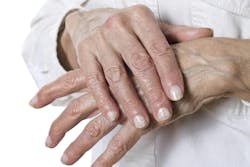Scientists at the National Institutes of Health (NIH) have discovered that the presence of a benign nail abnormality may lead to the diagnosis of a rare inherited disorder that increases the risk of developing cancerous tumors of the skin, eyes, kidneys and the tissue that lines the chest and abdomen (e.g., the mesothelium).
The condition, known as BAP1 tumor predisposition syndrome, is caused by mutations in the BAP1 gene, which normally acts as a tumor suppressor, among other functions. The findings are published in JAMA Dermatology and were presented at the Society for Investigative Dermatology Annual Meeting in Dallas.
Scientists happened upon the discovery while studying participants who were enrolled in a screening for BAP 1 variants at the NIH Clinical Center. As part of the study, a dermatology screening was performed at enrollment and annually for participants aged 2 and older. The cohort in the current study included 47 individuals with BAP1 tumor predisposition syndrome from 35 families.
Biopsies of the nail and underlying nail bed in several participants confirmed the investigators’ suspicion of a benign tumor abnormality known as an onychopapilloma. The condition causes a colored band (usually white or red) along the length of the nail, along with thickening of the nail underlying the color change and thickening at the end of the nail. It typically only affects one nail.
However, among study participants with known BAP1 tumor predisposition syndrome aged 30 and older, 88% had onychopapilloma tumors affect multiple nails. Researchers suggest that nail screening may be particularly valuable in a patient with a personal or family history of melanoma or other potential BAP1-associated malignancy.

